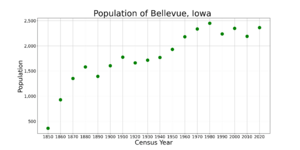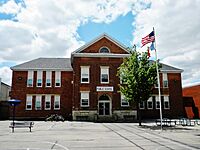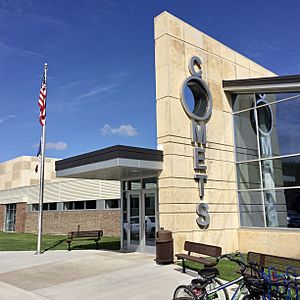Bellevue, Iowa facts for kids
Quick facts for kids
Bellevue, Iowa
|
|
|---|---|

Downtown Bellevue, Lock & Dam No. 12, and the Mississippi River from air.
|
|
| Motto(s):
"A True Riverfront Experience"
|
|
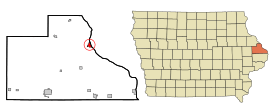
Location of Bellevue, Iowa
|
|
| Country | |
| State | |
| County | Jackson |
| Founded | July 2, 1836 |
| Incorporated | February 5, 1851 |
| Founded by | John D. Bell |
| Government | |
| • Type | Council-Administrator |
| Area | |
| • Total | 1.45 sq mi (3.74 km2) |
| • Land | 1.38 sq mi (3.56 km2) |
| • Water | 0.07 sq mi (0.18 km2) |
| Elevation | 607 ft (185 m) |
| Population
(2020)
|
|
| • Total | 2,363 |
| • Density | 1,718.55/sq mi (663.57/km2) |
| Time zone | UTC-6 (Central (CST)) |
| • Summer (DST) | UTC-5 (CDT) |
| ZIP code |
52031
|
| Area code(s) | 563 |
| FIPS code | 19-05635 |
| GNIS feature ID | 0454496 |
| Website | Bellevue, Iowa Website |
Bellevue is a city in eastern Jackson County, Iowa, United States. It sits along the Mississippi River at Lock and Dam No. 12. The city is also right next to Bellevue State Park. In 2020, about 2,363 people lived there. This was more than in 2010, making it the second-largest city in Jackson County.
Bellevue is located in a valley between two big hills called North and South Bluffs. The Mississippi River forms its eastern border, which is also the state line with Illinois. To the west, you'll find the Mill Creek valley. This area is part of the Driftless Area. This means it was not covered by glaciers during the last Ice Age.
Bellevue is one of the few cities in Iowa with large hills and bluffs. These natural features help bring in tourists. The city's name comes from French words 'Belle' and 'Vue', meaning 'beautiful view'. It was also named after an early settler, John D. Bell. Visitors come all year to see Bellevue's unique history and buildings. Many come from nearby cities like Dubuque and Maquoketa.
Contents
Bellevue's Interesting History
In 1837, Jackson County was created. Bellevue was chosen as the main town for Jackson, Jones, and Linn Counties. John D. Bell first planned the town in 1835. He built a cabin and became the first postmaster. The first hotel, the Bellevue House, opened in 1836.
When Iowa became a territory in 1838, Jackson County had 881 people. Bellevue built a city hall, which is now the Bellevue Public Library.
A conflict called the Bellevue War happened in 1840. This made people hesitant to settle there for a while. However, the population still doubled in two years. In 1838, Andrew became the county seat instead of Bellevue.
For many years, Andrew and Bellevue argued over which town should be the county seat. The county seat moved back and forth several times. In 1845, Bellevue built a county courthouse. This building is now Bellevue Elementary. It is the oldest school building still in use in Iowa.
Later, Maquoketa became the main town. This happened when the railroad reached Maquoketa in 1873. Maquoketa built a large city hall and offered it as a courthouse. People voted for this, and Maquoketa has been the county seat ever since.
Bellevue's Location and Weather
Bellevue covers about 1.41 square miles (3.7 square kilometers). Most of this area is land, with a small part being water.
Bellevue's Climate
Bellevue has a humid continental climate. This means it has four clear seasons. The weather here is often not as extreme as in other parts of the Midwest. Spring is usually wet and rainy. Summers are sunny and warm. Autumn is mild, and winters are typically cloudy and snowy.
| Climate data for Bellevue, Iowa (1991–2020 normals, extremes 1941–present) | |||||||||||||
|---|---|---|---|---|---|---|---|---|---|---|---|---|---|
| Month | Jan | Feb | Mar | Apr | May | Jun | Jul | Aug | Sep | Oct | Nov | Dec | Year |
| Record high °F (°C) | 63 (17) |
74 (23) |
87 (31) |
94 (34) |
95 (35) |
100 (38) |
103 (39) |
103 (39) |
99 (37) |
95 (35) |
77 (25) |
67 (19) |
103 (39) |
| Mean daily maximum °F (°C) | 28.9 (−1.7) |
33.5 (0.8) |
45.7 (7.6) |
59.3 (15.2) |
71.1 (21.7) |
81.1 (27.3) |
84.6 (29.2) |
82.7 (28.2) |
75.9 (24.4) |
62.6 (17.0) |
47.2 (8.4) |
34.2 (1.2) |
58.9 (14.9) |
| Daily mean °F (°C) | 20.5 (−6.4) |
24.3 (−4.3) |
36.0 (2.2) |
48.3 (9.1) |
59.8 (15.4) |
69.9 (21.1) |
73.6 (23.1) |
71.8 (22.1) |
64.0 (17.8) |
51.7 (10.9) |
38.3 (3.5) |
26.5 (−3.1) |
48.7 (9.3) |
| Mean daily minimum °F (°C) | 12.1 (−11.1) |
15.1 (−9.4) |
26.3 (−3.2) |
37.4 (3.0) |
48.4 (9.1) |
58.8 (14.9) |
62.7 (17.1) |
60.9 (16.1) |
52.2 (11.2) |
40.7 (4.8) |
29.3 (−1.5) |
18.9 (−7.3) |
38.6 (3.7) |
| Record low °F (°C) | −35 (−37) |
−34 (−37) |
−23 (−31) |
5 (−15) |
23 (−5) |
35 (2) |
41 (5) |
32 (0) |
24 (−4) |
14 (−10) |
−9 (−23) |
−26 (−32) |
−35 (−37) |
| Average precipitation inches (mm) | 1.30 (33) |
1.58 (40) |
2.16 (55) |
3.77 (96) |
4.21 (107) |
5.58 (142) |
4.33 (110) |
3.78 (96) |
3.65 (93) |
3.18 (81) |
2.34 (59) |
1.93 (49) |
37.81 (960) |
| Average snowfall inches (cm) | 9.3 (24) |
8.3 (21) |
3.9 (9.9) |
0.4 (1.0) |
0.1 (0.25) |
0.0 (0.0) |
0.0 (0.0) |
0.0 (0.0) |
0.0 (0.0) |
0.2 (0.51) |
1.3 (3.3) |
8.4 (21) |
31.9 (81) |
| Average precipitation days (≥ 0.01 in) | 8.2 | 7.7 | 8.7 | 10.6 | 12.4 | 10.7 | 9.0 | 8.4 | 8.5 | 8.2 | 8.0 | 8.6 | 109.0 |
| Average snowy days (≥ 0.1 in) | 5.1 | 4.1 | 1.8 | 0.2 | 0.0 | 0.0 | 0.0 | 0.0 | 0.0 | 0.1 | 0.8 | 4.2 | 16.3 |
| Source: NOAA | |||||||||||||
Who Lives in Bellevue?
| Historical populations | ||
|---|---|---|
| Year | Pop. | ±% |
| 1850 | 362 | — |
| 1860 | 929 | +156.6% |
| 1870 | 1,353 | +45.6% |
| 1880 | 1,581 | +16.9% |
| 1890 | 1,394 | −11.8% |
| 1900 | 1,607 | +15.3% |
| 1910 | 1,776 | +10.5% |
| 1920 | 1,663 | −6.4% |
| 1930 | 1,717 | +3.2% |
| 1940 | 1,771 | +3.1% |
| 1950 | 1,932 | +9.1% |
| 1960 | 2,181 | +12.9% |
| 1970 | 2,336 | +7.1% |
| 1980 | 2,450 | +4.9% |
| 1990 | 2,239 | −8.6% |
| 2000 | 2,350 | +5.0% |
| 2010 | 2,191 | −6.8% |
| 2020 | 2,363 | +7.9% |
| Source:U.S. Census Bureau and Iowa Data Center Source: |
||
The latest census in 2020 counted 2,363 people living in Bellevue. There were 1,011 households and 646 families. Most people (96.4%) were White. A small number were from other racial backgrounds. About 0.9% of the population was Hispanic or Latino.
In 2020, about 26.7% of households had children under 18. The average age in Bellevue was 44.6 years old. About 25.3% of residents were under 20. Also, 24.6% were 65 years or older. The city had slightly more females (52.2%) than males (47.8%).
Bellevue's Culture and Heritage
Bellevue has a rich history that has shaped its culture. Long ago, Woodland Native Americans lived in the fertile valleys here. Later, the Thâkîwaki and Meskwaki tribes also called this area home. You can still find evidence of their presence, like burial mounds on the south bluff.
European pioneers started settling here around 1833. They came as fur traders, farmers, and merchants. Many floated across the Mississippi River on logs. These early settlers founded "Bell View," which was one of Iowa's oldest cities. The name was later changed to the French "Belle Vue," and then combined to "Bellevue."
Today, the Sac and Fox Tribe of the Mississippi in Iowa still feel a strong connection to the Bellevue area.
Historic Places to Visit
Bellevue has several important historic sites. These places show the city's long and interesting past.
| Historical Site | Year Built | Location | Image | Description |
|---|---|---|---|---|
| Jackson County Courthouse | 1845 | 100 South Third Street, Bellevue | Bellevue was first named the county seat in 1837. This Greek Revival style courthouse was built in 1845. But in 1849, the county seat moved to Andrew. The building was used as the courthouse again from 1851 to 1861. After that, it became a public school. This type of courthouse is rare in Iowa today. | |
| Potter's Mill | 1843 | 300 Potter Drive, Bellevue | 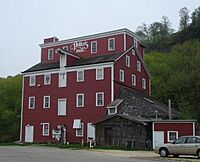 |
Potter's Mill was once a busy flour mill. It was built in 1843. Today, it is a tavern and bed and breakfast. It is listed on the National Register of Historic Places. The mill used water power from Mill Creek. Its flour products were known across the country. |
| George Dyas House | 1850s | 23852 362nd Avenue, Bellevue | The George Dyas House is part of the Dyas Farm. This home is made of limestone. It is one of the first limestone buildings in Jackson County. | |
| William Dyas Barn | 1850s | 41088 243rd Street, Bellevue | 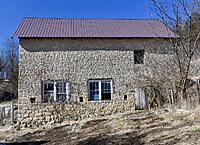 |
The William Dyas Barn is one of only nine limestone barns left in the county. It is still used today. The barn is built into a hillside. This means its second floor entrance is at ground level in the back. |
| Mont Rest | 1893 | 300 Spring Street, Bellevue | 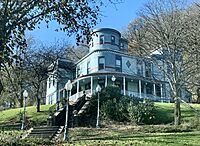 |
Seth Luellyn Baker, a rich land developer, built this house in 1893. He owned hotels and paddle boats on the Mississippi. Locals called Mont Rest "The Castle." This was because of its unique design and how it stood tall over the town. |
Schools in Bellevue
Bellevue has both public and private schools.
Public Schools
The Bellevue Community School District serves Bellevue and nearby towns. The school colors are royal blue and white. Their mascot is the Comets. Bellevue High School is on the west side of town. It shares a campus with the middle school and sports fields.
The high school was updated in 2010. They added a gym, stage, cafeteria, and new offices. Bellevue Elementary School is also part of the district. It is located in the old Jackson County Courthouse, built in 1845. The district offers free preschool through 12th grade. In 2019–2020, 765 students were enrolled.
Private Schools
Marquette Catholic is a private school in Bellevue. Its colors are red and white, and their team name is the Mohawks. It serves students from preschool through 12th grade. The school had major renovations in 2015. Buildings were connected, and a new gym and cafeteria were added. Marquette Catholic Schools also has Blessed Beginnings Daycare. About 240 students attend Marquette.
Getting Around Bellevue
Roads and Highways
Bellevue's main intersection is where US HWY 52 and Iowa HWY 62 meet. US HWY 52 goes north to St. Donatus and Dubuque. It goes south to Sabula and then into Savanna, Illinois. Highway 62 goes to Andrew and ends in Maquoketa. Other roads connect Bellevue to nearby towns like Cascade and La Motte.
River Travel
In the past, many river steamboats stopped in Bellevue. They carried people and goods. Today, the Mississippi River is still used for moving freight by barges. Large historical steamships sometimes stop in Bellevue for leisure cruises. Passengers can shop and eat while waiting for the Lock and Dam No. 12 to open.
The city has several places to launch boats. These include the Municipal Boat Ramp and Bellevue Public Area Ramp. Spruce Creek Park, north of Bellevue, also has a boat ramp and a harbor.
Airports
The closest medium-sized airport is Dubuque Regional Airport. Smaller local airports are in Maquoketa, Clinton, and Davenport. The nearest large commercial airport is Quad City International Airport in Moline, IL.
Railroads
A railroad runs through the center of Bellevue. It is used by long freight trains. This railway divides Second Street. Many streets cross this rail line. In the past, a narrow-gauge railway carried passengers. This railway closed in the 1930s. Today, the remaining railway is controlled by the Canadian Pacific Railway. There are no longer any passenger trains in Bellevue.
|
See also
 In Spanish: Bellevue (Iowa) para niños
In Spanish: Bellevue (Iowa) para niños





